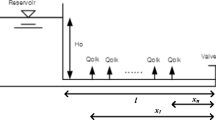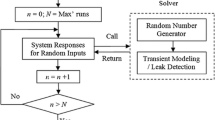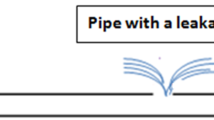Abstract
The transient frequency response (TFR) based pipe leak detection method has been developed and applied to water pipeline systems with different connection complexities such as branched and looped pipe networks. Previous development and preliminary applications have demonstrated the advantages of high efficiency and non-intrusion for this TFR method. Despite of the successful validations through extensive numerical applications in the literature, this type of method has not yet been examined systematically for its inherent characteristics and application accuracy under different system and flow conditions. This paper investigates the influences of the analytical approximations and assumptions originated from the method development process and the impacts of different uncertainty factors in practical application systems on the accuracy and applicability of the TFR method. The influence factors considered for the analysis contain system properties, derivation approximations and data measurement, and the pipeline systems used for the investigation include simple branched and looped multi-pipe networks. The methods of analytical analysis and numerical simulations are adopted for the investigation. The accuracy and sensitivity of the TFR method is evaluated for different factors and system conditions in this study. The results and findings are useful to understand the validity range and sensitivity of the TFR-based method, so as to better apply this efficient and non-intrusive method in practical pipeline systems.






Similar content being viewed by others
References
Ang HS, Tang WH (1975) Probability Concepts in Engineering Planning and Design, Volume II-Decision, Risk, and Reliability. Wiley, New York
Brunone B (1999) Transient test-based technique for leak detection in outfall pipes. J Water Resour Plan Manag, ASCE 125(5):302–306
Brunone B, Ferrante M (2001) Detecting leaks in pressurized pipes by means of transients. J Hydraul Res, IAHR 39(4):1–9
Colombo AF, Karney BW (2002) Energy and costs of leaky pipes: toward a comprehensive picture. J Water Resour Plan Manag, ASCE 128(6):441–450
Colombo AF, Lee PJ, Karney BW (2009) A selective literature review of transient-based leak detection methods. J Hydro Environ Res, IAHR 2(4):212–227
Covas D, Ramos H, Almeida AB (2005) Standing wave difference method for leak detection in pipeline systems. J Hydraul Eng, ASCE 131(12):1106–1116
Duan HF (2015) Uncertainty analysis of transient flow modeling and transient-based leak detection in elastic water pipelines. Water Resour Manag 29(14):5413–5427
Duan HF (2016) Transient frequency response based leak detection for water supply pipeline systems with branched and looped junctions. J Hydroinf, IWA 19(1):17–30
Duan HF, Ghidaoui MS, Tung YK (2010) Probabilistic analysis of transient design for water supply systems. J Water Resour Plan Manag, ASCE 136(6):678–687
Duan HF, Lee PJ, Ghidaoui MS, Tung YK (2011) Leak detection in complex series pipelines by using system frequency response method. J Hydraul Res, IAHR 49(2):213–221
Ferrante M, Brunone B (2003) Pipe system diagnosis and leak detection by unsteady-state tests-1: Harmonic analysis. Adv Water Resour 26(1):95–105
Ferrante M, Brunone B, Meniconi S (2009) Leak detection in branched pipe systems coupling wavelet analysis and a Lagrangian model. J Water Supply Res Technol 58(2):95–106
Ferrante M, Brunone B, Meniconi S, Karney BW, Massari C (2014) Leak size, detectability and test conditions in pressurized pipe systems. Water Resour Manag 28(13):4583–4598
Kim S (2016) Impedance method for abnormality detection of a branched pipeline system. Water Resour Manag 30(3):1101–1115
Lee PJ, Lambert MF, Simpson AR, Vítkovský JP, Liggett JA (2006) Experimental verification of the frequency response method for pipeline leak detection. J Hydraul Res, IAHR 44(5):693–707
Lee PJ, Duan HF, Ghidaoui MS, Karney BW (2013) Frequency domain analysis of pipe fluid transient behvaoirs. J Hydraul Res, IAHR 51(6):609–622
Liggett JA, Chen LC (1994) Inverse transient analysis in pipe networks. J Hydraul Eng, ASCE 120(8):934–954
Meniconi S, Brunone B, Ferrante M, Massari C (2011) Potential of transient tests to diagnose real supply pipe systems: what can be done with a single extemporary test. J Water Resour Plan Manag, ASCE 137(2):238–241
Meniconi S, Duan HF, Brunone B, Ghidaoui MS, Lee PJ, Ferrante M (2014) Further developments in rapidly decelerating turbulent pipe flow modeling. J Hydraul Eng, ASCE 140(7):04014028
Meniconi S, Brunone B, Ferrante M, Capponi C, Carrettini CA, Chiesa C, Segalini D, Lanfranchi EA (2015) Anomaly pre-localization in distribution-transmission mains by pump trip: preliminary field tests in the Milan pipe system. J Hydroinf 17(3):377–389
Mpesha W, Gassman SL, Chaudhry MH (2001) Leak detection in pipes by frequency response method. J Hydraul Eng, ASCE 127(2):134–147
Sattar AM, Chaudhry MH (2008) Leak detection in pipelines by frequency response method. J Hydraul Res, IAHR 46(EI1):138–151
Sun JL, Wang R, Duan HF (2016) Multiple-fault detection in water pipelines using transient time-frequency analysis. J Hydroinf 18(6):975–989
Tung YK, Yen BC, Melching CS (2006) Hydrosystems Engineering Reliability Assessment and Risk Analysis. McGraw-Hill Company, Inc., New York
Vítkovský JP, Simpson AR, Lambert MF (2000) Leak detection and calibration using transients and genetic algorithms. J Water Resour Plan Manag, ASCE 126(4):262–265
Wang XJ, Lambert MF, Simpson AR, Liggett JA, Vítkovský JP (2002) Leak detection in pipeline systems using the damping of fluid transients. J Hydraul Eng ASCE 128(7):697–711
Acknowledgments
This paper was supported by the research grants from: (1) the Hong Kong Research Grant Council under the projects no. T21-602/15-R, no. 25200616 and no. 15201017; and (2) the Hong Kong Polytechnic University (HKPU) under projects no. 1-ZVCD and no. 3-RBAB.
Author information
Authors and Affiliations
Corresponding author
Ethics declarations
I declare herein that the submitted paper (WARM-D-17-00283) is original and unpublished elsewhere, and that this manuscript complies with the Ethical Rules applicable for this journal.
Conflict of Interest
No conflict of interest.
Rights and permissions
About this article
Cite this article
Duan, HF. Accuracy and Sensitivity Evaluation of TFR Method for Leak Detection in Multiple-Pipeline Water Supply Systems. Water Resour Manage 32, 2147–2164 (2018). https://doi.org/10.1007/s11269-018-1923-7
Received:
Accepted:
Published:
Issue Date:
DOI: https://doi.org/10.1007/s11269-018-1923-7




